Roman BlindsThere are several options you can have when choosing your blind: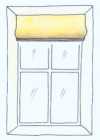 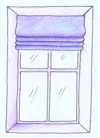 - Regular or Cascade Pockets. Regular Pockets is when the blind folds up in equal sections, one in front of the other.
Cascade pockets is when each section of the blind, when folded, is of a a shorter length. The pocket sizing is staggered so that smaller folds occur towards the top and front of the blind when it is folded up, creating a cascade effect.When choosing between the two types of pockets, bear in mind that Regular pockets are more 'efficient' in that the blind is more compact when pulled up and will obscure less of the window. Cascade pockets give rise, on average, to a deeper size of the folded blind. The size of each ripple in the cascade adds about 2.5cm to the folded depth. Note that it is best not to combine cascading pockets with a shaped or zigzag bottom - it's rather gilding the lily, and will create a greater depth when pulled up since you increase depth both through the cascade and the bottom.That said, if you have reasonably deep drop on the window, a cascade with a border at the base looks very effective, as the extra area folded takes up on your window probably does not matter too much in terms of obscuring the light. - Drawpull Left or Right. Simple enough, this just says which side of the blind the cord goes. You fasten the cord to a cleat (supplied) on the window frame or wall. You can actually change the side of this when you get the blind if you change your mind, you just have to re-string the blind (instructions supplied).
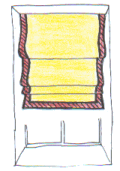 - Borders. You can have a border around the blind in a contrasting fabric, the border width being at your discretion. We usually recommend 2cm or 5cm for a border that runs down the two sides of the blind and optionally along the bottom edge, but for a bottom border you can go up to 20cm deep.The border runs from the perimeter of the blind inwards, and you can have either bottom only, bottom and sides , or sides only. The border goes right up to the edge of the blind - we don't do inset borders.
- Band. A similar concept to the border, you can have a wide horizontal inset band running across the blind, again in a contrasting fabric. This band of colour can be up to 20cm wide (ie height).The band is set in the bottom is set in the bottom 1/3 of the blind approximately 8-20cm up from the base, depending on the overall drop.This design option works well with cascade pockets.
- Eyelet Bottom. You can have a fashionable row of eyelets punched along the bottom of the blind.
- The eyelets are approximately 4cm in diameter, in black or silver, and we would choose to drop the bottom of the blind
when folded up to leave them on view. This adds an extra 5-6cm to the overall depth of the folded blind, so on shorter blinds we would choose to tuck the row
of holes up behind the other folds, so that it would not be on show when the blind was folded, thereby not obscuring too much light.
Obviously, light will come through the holes - something to bear in mind if choosing this type of blind for the bedroom!
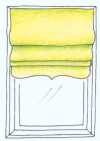 - Shaped Bottoms. You can have the bottom of the blind cut to the traditional 'shaped blind' pattern. The bottom is 3-6cm in height and note that the overall drop measurement you state on your order is inclusive of this section. That means that the blind we make up will have a drop equal to the distance from the top of the blind to the lowermost point on the shaped bottom. Because the shaping at the bottom of the blind is an obvious source of light leakage, you might want to consider making your blind a little longer, providing you have room, and are not setting the blind in a recess.
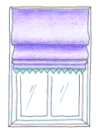 - ZigZag Bottoms. You can have the bottom of the blind cut in the shape of a zigzag, and you can either have this in the same fabric as the blind, or in a contrasting fabric. The bottom is 3-5cm in height and when the drop measurement is inclusive of this section (see comments above on Shaped Bottoms).
Lining- Choose from standard lining or blackout lined (we don't do unlined blinds or curtains, we think its false economy, except of course in the case of voile curtains, as unshielded sunlight damages the face fabric very quickly).
- Standard lining is a cream coloured cotton sateen (basically a thin cotton).
- Blackout lining is also a cream coloured cotton, but its a very slightly heavier and is treated to make it 100% lightproof. It's a very effective idea for a bedroom or even a living room that has the occasional visitor.
InterliningOptionally choose to have your blind interlined. This makes for greater warmth, light blocking and makes for a softer, cosier look.More than one Blind/Curtain in the same fabric in one Room
When you specify your blind we ask if there are other blinds in the room that you are ordering that are of the same fabric.
This is only relevant if there is a vertically repeating pattern in the fabric, something which we point out on the fabric pages.
For plain and vertically striped fabrics, the question is irrelevant.
Where there is a vertical repeat and you are ordering more than one blind in a room, we endeavour to create some regularity between the blinds, by reviewing the alignment of the pattern in each blind, and this may involve a little more fabric. Note however, that because we haven't seen your room, we can't make any guarantees about alignment.
|

























